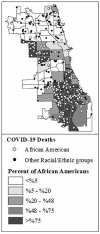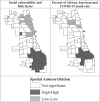Social Vulnerability and Racial Inequality in COVID-19 Deaths in Chicago
- PMID: 32436405
- PMCID: PMC8183499
- DOI: 10.1177/1090198120929677
Social Vulnerability and Racial Inequality in COVID-19 Deaths in Chicago
Abstract
Although the current COVID-19 crisis is felt globally, at the local level, COVID-19 has disproportionately affected poor, highly segregated African American communities in Chicago. To understand the emerging pattern of racial inequality in the effects of COVID-19, we examined the relative burden of social vulnerability and health risk factors. We found significant spatial clusters of social vulnerability and risk factors, both of which are significantly associated with the increased COVID-19-related death rate. We also found that a higher percentage of African Americans was associated with increased levels of social vulnerability and risk factors. In addition, the proportion of African American residents has an independent effect on the COVID-19 death rate. We argue that existing inequity is often highlighted in emergency conditions. The disproportionate effects of COVID-19 in African American communities are a reflection of racial inequality and social exclusion that existed before the COVID-19 crisis.
Keywords: African American; GIS; emergency; general terms; health disparities; health equity; neighborhood; place; population groups; risk and crisis communication.
Conflict of interest statement
Figures




References
-
- Browning C., Feinberg S., Wallace D., Cagney K. (2006). Neighborhood social processes, physical conditions, and disaster-related mortality: The case of the 1995 Chicago heat wave. American Sociological Review, 71(4), 661–678. 10.1177/000312240607100407 - DOI
-
- Burgess E. W., Park R. E. (1984). The city. University of Chicago Press.
-
- Burton C., Rufat S., Tate E. (2018). Social vulnerability: Conceptual foundations and geospatial modeling. In Fuchs S., Thaler T. (Eds.), Vulnerability and resilience to natural hazards (pp. 53–81). Cambridge University Press.
Publication types
MeSH terms
Grants and funding
LinkOut - more resources
Full Text Sources
Medical

